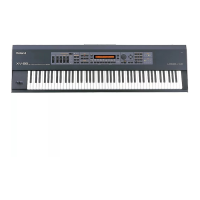73
Chapter 5. Creating Patches
Chapter 5
L.Fade (Velocity Fade Width Lower)
U.Fade (Velocity Fade Width Upper)
L.Fade and U.Fade set the range within which the volume
gradually fades as the velocity approaches the limits of the
Velocity Range as set by the Lower and Upper parameters.
Use this setting when, for example, you want to have
adjacent Tones in Split mode switched smoothly (Velocity
Crossfade). The higher the values set, the smoother the
switch is between the Tones. When you want the Tones to be
switched instantly, set these to 0.
fig.05-17.e
TMT KEY RANG (TMT Key Range)
fig.05-18
These parameters specify the range of notes that will play the
Tone. This can be used to make notes in different areas of the
keyboard play different Tones.
Lower (Key Range Lower)
Upper (Key Range Upper)
Specify the lower (Lower) and upper (Upper) limits in which
each Tone will sound.
If you attempt to raise the lower key higher than the upper
key, or to lower the upper key below the lower key, the other
value will be automatically modified to the same setting.
L.Fade (Key Fade Width Lower)
U.Fade (Key Fade Width Upper)
L.Fade and U.Fade set the range within which the volume
gradually fades as the velocity approaches the limits of the
Key Range set in the Lower and Upper parameters. Use this
setting when, for example, you want to have adjacent Tones
in Split mode switched smoothly. The higher the values set,
the smoother the switch is between the Tones. When you
want the Tones to be switched instantly, set these to 0.
fig.03-07.e
STRUCT (Structure)
fig.05-19
Type (Structure Type)
Determines how Tone 1 and 2, or Tone 3 and 4 are connected.
The following 10 different Types of combination are
available.
The display will show how the Tones are combined. The
displayed symbols have the following meanings.
W1 (WG1), W2 (WG2), F1 (TVF1), F2 (TVF2), A1 (TVA1),
A2 (TVA2), B (booster), R (ring modulator)
fig.05-20
With this type, Tones 1 and 2 (or 3 and 4) are independent.
Use this type when you want to preserve PCM sounds or
create and combine sounds for each Tone.
fig.05-21
This type stacks the two filters together to intensify the
characteristics of the filters. The TVA for Tone 1 (or 3)
controls the volume balance between the two Tones.
fig.05-22
This type mixes the sound of tone 1 (3) and tone 2 (4), applies
a filter, and then applies a booster to distort the waveform.
Lower
Upper
L.Fade
U.Fade
Level
Velocity
Lower
Upper
L.Fade
U.Fade
Level
Pitch
TONE 1 (3)
TONE 2 (4)
TVATVF
WG
WG
TVF TVA
TYPE 1
TONE 1 (3)
TONE 2 (4)
TVA
TVF
WG
WG
TVF TVA
TYPE 2
TONE 1 (3)
TONE 2 (4)
TVA TVF
WG
WG
TVF TVA
B
TYPE 3

